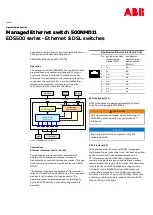
8-4
To do…
Use the command…
Remarks
Configure the track-static routing
collaboration, so as to check the
reachability of the next hop of the
static route
ip route-static dest-address
{
mask
|
mask-length
}
next-hop-address
track
track-entry-number
[
preference
preference-value
] [
tag tag-value
]
[
description description-text
]
Required
Not configured by default.
z
For the configuration of Track-Static Routing collaboration, the specified static route can be an
existent or nonexistent one. For an existent static route, the static route and the specified Track
object are associated directly; for a nonexistent static route, the system creates the static route
and then associates it with the specified Track object.
z
The Track object to be associated with the static route can be a nonexistent one. After you use
the
track
command to create the Track object, the association takes effect.
z
If a static route needs route recursion, the associated Track object must monitor the next hop of
the recursive route instead of that of the static route; otherwise, a valid route may be considered
invalid.
z
For details of static route configuration, refer to
Static Routing Configuration
in the
Layer 3 - IP
Routing Configuration Guide
.
Displaying and Maintaining Track Object(s)
To do…
Use the command…
Remarks
Display information about the
specified Track object or all Track
objects
display
track
{
track-entry-number
|
all
}
Available in any view
Track Configuration Examples
Static Routing-Track-NQA Collaboration Configuration Example
Network requirements
As shown in
, Switch A, Switch B, Switch C, and Switch D are connected to two segments
20.1.1.0/24 and 30.1.1.0/24. Configure static routes on these switches so that the two segments can
communicate with each other, and configure route backup to improve reliability of the network.
Switch A is the default gateway of the hosts in segment 20.1.1.0/24. Two static routes to 30.1.1.0/24
exist on Switch A, with the next hop being Switch B and Switch C respectively. These two static routes
back up each other, where:








































